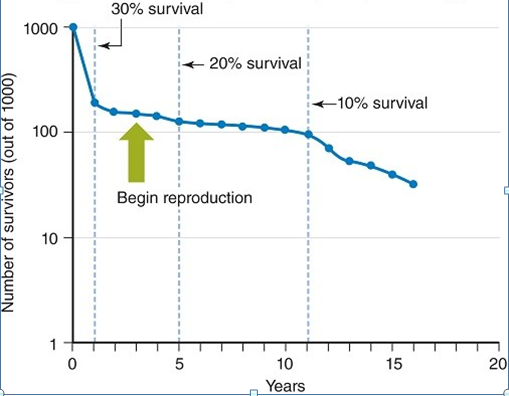Angiosperms are referred to as ________ when the male and female reproductive parts are on different individuals of the same species.
A. monoecious
B. tetraploid
C. bryophytes
D. dioecious
Answer: D
You might also like to view...
Lysogeny refers to
A. the latent state of herpes infections. B. virions exiting host cell. C. altering the host range of a virus. D. the viral genome inserting into bacterial host chromosome.
The constructive phase of coral reef formation involves:
a. consumption of soft corals by crown of thorns sea stars. b. settling of planula larvae. c. Halimeda growth. d. both a and c
In this graph of yellow-eyed penguins, the data indicate that

A. 10% of the yellow-eyed penguins live to eleven years of age.
B. reproductive age of the yellow-eyed penguins is three years.
C. most of the yellow-eyed penguins die in their first year of life.
D. All of the answer choices are correct.
E. just less than 30% of the yellow-eyed penguins survive to reproductive age.
Water in a pond contaminated with the weed killer atrazine is suspected of inhibiting metamorphosis in northern leopard frogs. A team of scientists collected fertilized northern leopard frog eggs from a different pond that is not contaminated. Which of the following is the best experimental design to determine whether atrazine is responsible for inhibiting metamorphosis in northern leopard frogs?
(A) Place half of the fertilized eggs in a pool of water with the same concentration of atrazine as the contaminated pond and place the other half of the fertilized eggs in a pool of water that has no atrazine. Monitor the development of the embryos through metamorphosis into adulthood. (B) Place all of the fertilized eggs in a pool of pond water with the same concentration of atrazine as the contaminated pond and compare the number of frogs that reach metamorphosis to those that reach adulthood in the contaminated pond. (C) Allow all fertilized eggs to develop into adults. Expose one-third of the frogs to one-half of the concentration of atrazine in the contaminated pond and expose another one-third of the frogs to the same concentration of atrazine as the contaminated pond. Leave the last one-third of the frogs in water with no atrazine and note any adverse changes in the physical condition of the atrazine-treated frogs in three months. (D) Divide the fertilized eggs into three groups and expose each group to a different concentration of atrazine. Release the eggs back into the contaminated pond and check for metamorphosis after three months.